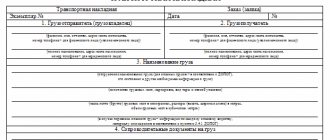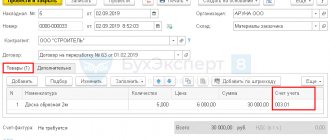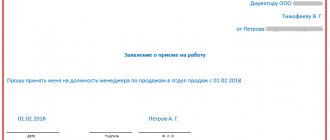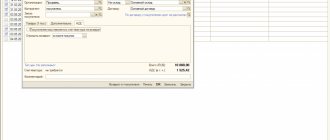Kontur.Accounting is a web service for small businesses!
Quick establishment of primary accounts, automatic tax calculation, online reporting, electronic document management, free updates and technical support.
Try it
To organize efficient production, it is important to maintain competent warehouse records. Knowing the documents used to register goods in the warehouse will help you protect your rights and keep records correctly. Correctly executed documentary support will protect against problems with the received goods and facilitate communication with the tax authorities.
Documents for registration of goods receipt
The posting of goods includes the reception and initial accounting of receipts. The goods can be accepted by a financially responsible person or a person by proxy. The receipt of goods is accompanied by the execution of primary documents by the supplier. These include:
- packing list;
- waybill (Bill of Lading) - it is needed to take into account the movements of goods and materials and pay for road transport;
- invoice.
An invoice is issued if the supplier pays VAT. An invoice allows you to offset VAT on the goods received for reimbursement. Organizations and entrepreneurs operating under the simplified taxation system do not pay value added tax and may not issue an invoice, and if the document is issued by the supplier on OSNO, they may not accept input VAT for reimbursement.
Before accepting the goods, check the correctness of the invoice: it must contain the details of the buyer and supplier, name of the product, quantity, price, cost, VAT.
The cloud service Kontur.Accounting allows you to store all information about goods in one place and simplifies the procedure for posting goods. Get free access for 14 days
To post the goods after acceptance, the invoice is stamped and signed by the responsible persons. The invoice is drawn up in two copies: one remains with the buyer, and the other is given to the seller. For the buyer, the invoice is a receipt document, and for the seller it is an expense document.
Receipt order
When materials arrive at the warehouse, the material responsible person (for example, a storekeeper) must draw up a receipt order using the unified M-4 form or his own developed form. A separate receipt order is issued for each delivery.
One order can be drawn up if several batches of bulk homogeneous cargo are received from one supplier during the day. At the end of the day, the total total for all cargo is determined.
A receipt order is not drawn up if quantitative and qualitative discrepancies are identified during the acceptance of materials.
The receipt order is transferred to the accounting department along with accompanying documents. The accountant receives materials based on the order and enters a corresponding invoice.
The order is kept in the accounting department for 5 years.
Universal transfer document (UDD)
This document is both a waybill and an invoice. Legislatively introduced in 2013 and not mandatory for use. You can decide for yourself whether you want to draw up two documents or just the UPD. Like an invoice, UTD provides the basis for obtaining a tax deduction.
The use of a universal document simplifies the process of transfer and acceptance of inventory items. Use it to formalize the supply of goods, works or services and the transfer of property rights. The UPD is signed by the authorized person responsible for the preparation of primary documents or purchase and sale transactions.
In the legally established form of the UPD there is a status field. It determines which document you are submitting the UPD instead of:
- Invoice and delivery note;
- Packing list;
- Invoice (for electronic form).
The status of the document changes the order in which it is filled out: for status 2, you do not need to fill out some lines, the UPD number and the required signatures change. To use the UPD in an organization, its form must be approved. The official form is advisory in nature, and the organization may make changes to it. But all mandatory details of the primary documents must comply with the requirements.
Shortage, surplus or mis-grading upon receipt of goods
Receiving goods is one of the most important procedures in the operation of a warehouse or store. If a shortage or excess quantity of products is not noticed during the receipt process, then in the future this will negatively affect its accounting.
The most common mistake that occurs when receiving goods is their shortage.
There are several reasons for this:
- the supplier made a mistake when loading transport at its warehouse;
- non-compliance with the quality characteristics declared by the supplier, including damage to the goods during transportation;
- error when posting goods.
If a shortage is identified due to a discrepancy in quality or quantity, it is necessary to fill out a report in the form TORG-2 (for Russian products) and according to TORG-3 (for imported supplies).
If you receive a quantity of products exceeding that specified in the contract, you can:
- draw up a notice of return of the surplus;
- accept all goods and agree to receive a discount;
- independently decide on the sale of excess quantity, taking into account the costs of finding a buyer and shipping products;
- return the products to the supplier if this condition is specified in the contract.
All actions that will be carried out after identifying a surplus must be agreed upon with the organization that shipped the products, or described in advance in the contract.
If a shortage of one type of product and a surplus of another is detected, it is necessary to draw up documents about the re-grading in the TORG-2 form (or TORG-3, if you are selling imports) and file a claim with the supplier. According to the rules for acceptance of goods, such delivery can be accepted in full, not accepted, or accepted partially.
For example, when ordering 100 packs of milk with 2.5% fat content, the store delivered 80 packs of 2.5% fat and 20 packs of 3% fat.
In this case, the rules for accepting goods in a store allow the following options:
- accept all delivered products;
- take 80 packs of 2.5% fat;
- refuse to accept all delivered products.
Acceptance of goods
The cloud service Kontur.Accounting allows you to store all information about goods in one place and simplifies the procedure for posting goods. Get free access for 14 days
At the first stage of acceptance of goods, we check whether the type and quantity of goods corresponds to the information in the accompanying documents. This is necessary to ensure completeness of accounting. The second stage is acceptance of the goods for quality and completeness. Acceptance of goods is carried out by the materially responsible person in the presence of a representative of the supplier, unless other conditions are specified in the contract. If all goods are in place and no defects are found, confirm compliance with the organization’s stamp and signature.
Based on the results of acceptance of the goods, a TORG-1 act and a TORG-11 product label are drawn up. Product label data is needed to conduct an inventory list.
Violation of the inspection deadlines and acceptance rules will deprive you of the right to file a claim against the supplier or carrier. For certain types of goods, the terms are established by law, for others they are specified in the contract. Registration of the return of low-quality goods depends on the moment of detection of the defect:
- if a shortage of goods or defects is detected during acceptance, the commission draws up a report on the discrepancy in quantity and quality; the act is drawn up in the TORG-2 form; if properly executed, it will serve as the basis for making claims;
- when a defect is discovered after the goods are registered, an invoice is drawn up indicating the quantity of the goods being returned, a statement of identified defects, a letter of claim and a return invoice;
- if one of the types of goods was not delivered to you, cross them out from the invoice and adjust the invoice.
At the end of acceptance, capitalize the received goods and materials according to the actual quantity and amount.
Accounting stages and their documentation
A warehouse worker will have to deal with many forms. Let's build a logical sequence based on the stages of accounting.
Table. List of warehouse documents.
| Accounting Component | What is this | Samples of warehouse documents | Why are they needed? | Number of copies |
| Admission | Packing list | TORG-12 | Find out complete information about incoming goods and materials | Two: one - from the seller, the second - from the buyer |
| Invoice for issue of materials to the side | M-15 | Receive goods and materials from another address | ||
| Receipt order | M-4 | Record arrival | One with the signatures of the storekeeper and the forwarder | |
| Deed of variance | TORG-2 | Document discrepancies in quantity and quality | Four: for the seller, the buyer, the transport company and in the application to the claim | |
| Receipt from the cash register | Fiscal receipt | Confirm the purchase | Two: one for the buyer, the second for the Federal Tax Service | |
| Warehouse list, act, certificate | Others | Prove the fact of arrival of goods and materials if received in another way | ||
| Actual accounting | Party card | MX-10 | Take into account goods of the same name or arrived by the same vehicle | Two: one remains in the warehouse, the second goes to the accounting department |
| Material accounting card | M-17 | Consider materials by grade and type | One | |
| Internal movement | Request-invoice | M-11 | Confirm the movement of inventory items within the organization (between departments) | Two: one remains in the issuing department, the other goes to the warehouse |
| Inventory | Inventory order | INV-22 | Initiate a check indicating the reason | One - for the chairman of the inventory commission |
| Inventory list | INV-3 | Reflect the actual availability of inventory items | Two: one is for the MOL, the other goes to the accounting department | |
| Collation statement | INV-19 | Record deviations from accounting indicators | ||
| Inventory record sheet | INV-26 | Submit your results | Two: one remains in the warehouse, the second goes to the accounting department | |
| Storage | Certificate of acceptance and transfer of goods and materials for storage | MX-1 | Register acceptance under a storage agreement | In accordance with agreement |
| Log book of inventory items deposited for storage | MX-2 | Confirm that the bailor has no claims | One | |
| Disposal | Limit fence card | M-8 | Reflect the issue of materials if there are limits | Two: one remains in the warehouse, the other goes to the receiving department |
| Invoice for issue of materials to the side | M-15 | Transfer goods and materials to another address | Two: one - from the seller, the second - from the buyer | |
| Request-invoice | M-11 | Confirm the movement of inventory items within the organization (between departments) | Two: one remains in the warehouse, the other goes to the receiving department | |
| Packing list | TORG-12 | Provide complete information about incoming inventory items | Two: one - from the seller, the second - from the buyer |
What to do if there are no accompanying documents
The cloud service Kontur.Accounting allows you to store all information about goods in one place and simplifies the procedure for posting goods. Get free access for 14 days
For accounting, the main thing is documents. If there is no document, there is no accounting object. When a supply agreement is available, but the supplier has not provided accompanying documents, the goods received must also be capitalized.
For such cases, a TORG-4 acceptance certificate is provided. In the absence of a delivery note and an invoice, it is difficult to determine the price at which the goods arrive. The price must be taken from the contract, and if there is no contract, then the goods are purchased at the market price. The TORG-4 act contains information about the actual availability of the received goods.
The acceptance certificate is drawn up by a special commission that accepts the goods. TORG-4 is drawn up in two copies, one is transferred to the financially responsible person of the supplier, and the other to the accounting department.
Accompanying documents
The supplier brings accompanying documents along with the goods. Usually these are invoices and invoices, but variations are possible.
TORG-12
The TORG-12 consignment note is a document that serves as the basis for the transfer of inventory items from one organization to another. The consignment note records the relevant transactions.
Consignment note
Consignment note (Bill of Lading) is a document that is used to record inventory items when they are moved by vehicles. The TTN has two sections, the first describes the goods and names the counterparties, the second indicates the route and composition of transport services.
All invoices are issued in two copies, for the store and the supplier.
Invoice
In cases where VAT is charged on goods, the seller is obliged to send the buyer an invoice, which is the basis for accepting the goods. The invoice is printed in one copy - for the store.
UPD
The universal transfer document is based on the invoice, but includes information from TORG-12, TTN and other primary documents.










